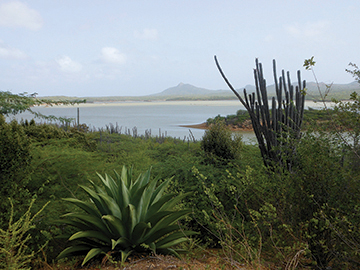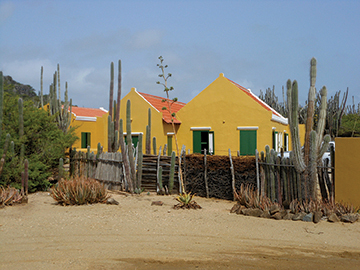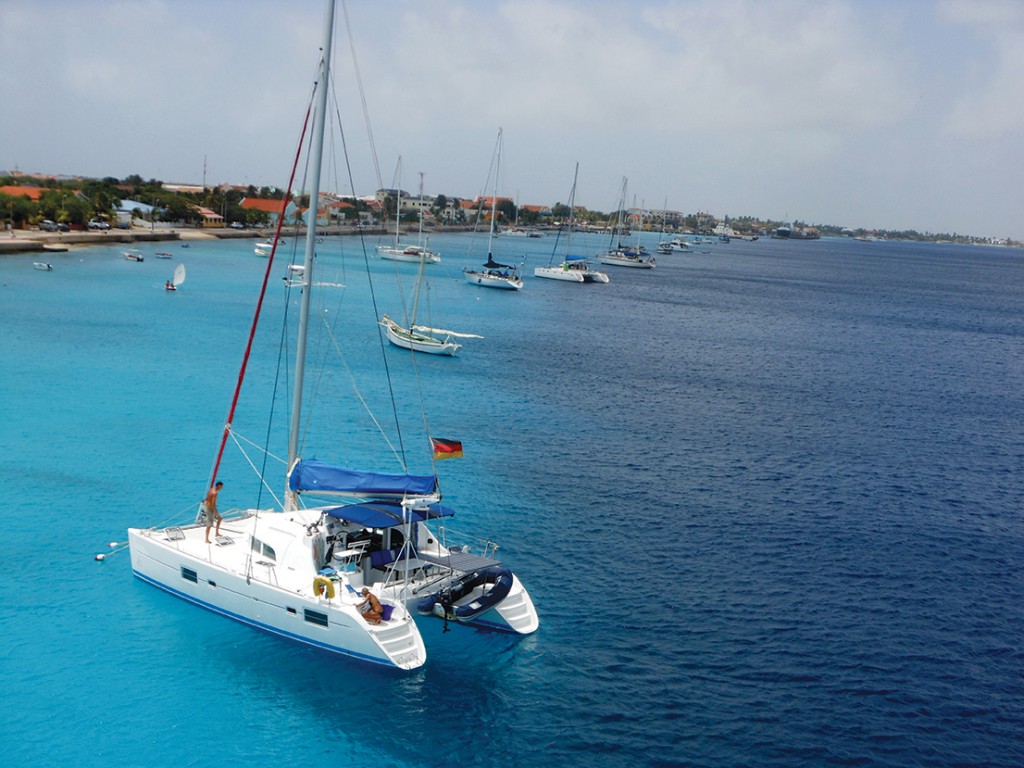Spend hurricane season soaking in Bonaire’s laid back beauty (published April 2013)
It was June 1, 2012, the opening day of hurricane season, and Sinbad, our 42’ Whitby ketch, was underway from Les Saintes, Guadeloupe, bound for Bonaire to spend the summer in the Netherlands Antilles.We sailed southwest across the Caribbean Sea for four and a half days under jib and jigger with following winds and seas, and finally sighted the lighthouse at the northern tip of Bonaire as darkness fell. Sheltered from brisk winds, we eased back and forth along the northwest coast in the lee of the island until the stars faded and we could approach the anchorage in daylight.

Bonaire’s “anchorage” is really a mooring field. Anchoring is prohibited as nearly the entire coastline has been designated a national underwater park. So we picked up a mooring, made ourselves presentable and dinghied to the customs dock. Two massive seagoing tugboats moored at the pier make the dock easy to spot in the downtown area and customs and immigration is open 24 hours a day, seven days a week, which makes clearing in relatively simple and quick. After checking in, we took the dinghy to the Harbor Village Marina—easily distinguishable by it’s landmark lighthouse—to pay for our mooring ball. The fee of $10 per day supports the national park system and solid waste removal for cruisers.
LIFE AQUATIC
The mooring balls lie in about 16 feet of water and the reef falls off steeply within a few boat lengths. The water is sparkling clear, with over 100’ visibility most days. We could jump off the boat and be right above the reef, teeming with colorful fish and coral. Soon after we arrived, a large school of blue tangs swam by and proceeded to nibble most of the algal growth off the bottom of our boat, which, over the course of a few days, saved us hours of bottom cleaning time.
 Snorkeling quickly became a twice-daily habit. We were able to enjoy the beauty of the reef as well as the shallower waters closer to shore where we glided over bonefish, octopi, eels and a rainbow of juvenile reef fishes. Also, while snorkeling near the entrance to the marina, a manta ray skated past us at close range. On calm days we took the dinghy across the channel to explore the lush coral gardens surrounding Klein Bonaire, an uninhabited island less than a mile away from our mooring.
Snorkeling quickly became a twice-daily habit. We were able to enjoy the beauty of the reef as well as the shallower waters closer to shore where we glided over bonefish, octopi, eels and a rainbow of juvenile reef fishes. Also, while snorkeling near the entrance to the marina, a manta ray skated past us at close range. On calm days we took the dinghy across the channel to explore the lush coral gardens surrounding Klein Bonaire, an uninhabited island less than a mile away from our mooring.
Numerous dive shops in Bonaire will cheerfully support your snorkeling and diving needs; you can book a dive excursion, rent a full kit of equipment or simply get tanks filled if all you need is air. The friendly staff at Dive Friends Bonaire—the “Yellow Submarine” shop overlooking the mooring field—were very accommodating when we went in to buy Randy a new mask and to replace my 30 year-old snorkel that had finally disintegrated. I also bought books about fish and reef creature identification and a cool magnifying glass, which made fish spotting wonderful daily entertainment.

COMMUNITY EVENTS
We also volunteered to spend a couple hours picking up underwater litter in one of the quarterly cleanup dives sponsored by Bonaire’s business and dive community. The area chosen for the cleanup was the city pier, which is normally closed to diving. The mature sponge and coral formations on the pilings were spectacularly colorful and hundreds of pounds of litter and debris were collected. That evening, the cleanup volunteers, including the crews of sailing vessels Sinbad, Apparition and Wildest Dream, were treated to a party with barbeque, delicious potluck and a DJ. We had a great time getting to know some of the local community members and helping to preserve the underwater beauty of Bonaire.
In October, the Heineken Regatta attracts many sailors to the Netherlands Antilles, which is a forum for brisk competition between the youth and young adults who sail Optimists, Sunfish and Lasers. From our mooring, we had a front row seat and really enjoyed watching the races. In the evening, the yacht club and downtown host food booths, live music and an international parade.
Also part of the festivities is the annual open water swim from Bonaire to Klein Bonaire, which is a fundraiser for local youth services. Over 300 swimmers participated in the event and all ages and levels of swimmers are welcome and allowed to use any assists, including fins, mask and floaties. Randy and two other cruiser crews helped out by using their dinghies as escort safety boats for the swimmers. With a few weeks of fairly relaxed “training” and some long-ago high school swim team experience, I was able to finish among the first third of swimmers. Afterward, we mingled and chatted with local participants while enjoying box lunches, fruit and drinks that were provided.

BONAIRE ASHORE
Exploring the small, friendly city of Kralendijk on foot can be easily done in a day or two. There is a small assortment of shops to browse for clothing and tourist items. In town, the TOP/Cultimara grocery store is only a few blocks from the waterfront. Specialty foods and fresh produce can be found at Cash and Carry Wholesale (aka “the Big Box store”) and the Van den Tweel Supermarket is about a mile-and-a-half from town center.
Caribbean Laundry Services will send a van to collect cruisers and their laundry for free and offers drop-off service as well as self-serve machines. Marine supplies are limited to a small Budget Marine store; the nearest rigger, sailmaker or other such services are in Curacao. Fast Internet connections via external plug-in modem are available through Digicel, and there is free Wi-Fi at the ice cream shop. It’s a nice bonus to catch up on email while savoring a coconut gelato.
We rented a car to explore the rest of the island and headed north toward the Washington Slagbaai National Park. The climate of Bonaire is hot and arid—it’s red earth and fossil coral landscape scantily shaded by cacti and thorny scrub. The north end of the island seemed hotter still and we gratefully drank several bottles of water, a necessity to pack along when traveling the island.

At the park entrance is a Dutch colonial farmhouse and small museum where we stopped to learn about the island’s history, folkways and wildlife. Driving farther into the park, the road leads past cliffs on the rugged windward shore and up to the lighthouse that guided our night time approach. We picnicked on sausage, cheese, olives and crusty bread inside the freshly painted lighthouse and enjoyed panoramic views of the park. We continued on through towering cactus groves, where green parrots fed on the cactus fruit and yellow and black orioles called “trupials” sang their melodious songs, to a salt pond colored reddish by brine shrimp and host to a flock of Bonaire’s iconic pink flamingos.
The southern end of Bonaire is home to giant evaporation ponds where seawater yields mountains of sea salt in commercial quantities, as it did in colonial times. Here too, the salt ponds are tinted fantastic shades of pink and red by salt-loving microbes and flamingoes wade feeding. We stopped to explore the nearby slave huts by the sea, where enslaved salt workers rested their weary bones at day’s end.
 Hot and tired, it was time to head back. We stopped in town at Karels’, the landmark eatery and pub situated on a pier with a convenient dinghy dock. Under the shade of large umbrellas we dug into piles of crispy fries with mayonnaise and Karel’s signature burgers smothered with gouda cheese, mushrooms and bacon,while drinking cold beer and loads more ice water.
Hot and tired, it was time to head back. We stopped in town at Karels’, the landmark eatery and pub situated on a pier with a convenient dinghy dock. Under the shade of large umbrellas we dug into piles of crispy fries with mayonnaise and Karel’s signature burgers smothered with gouda cheese, mushrooms and bacon,while drinking cold beer and loads more ice water.
Prior to our visit to Bonaire, we were unable to locate any reliable cruising guides and those few we heard of were old and out of print. Fortunately, on October 25, 2012, sailor and cruising guide author Frank Virgintino released his free downloadable cruising guide to the ABC islands, available at FreeCruisingGuides.com/abc-islands. It is a comprehensive and informative resource to peruse if you are considering visiting the ABC’s. We really enjoyed the natural beauty, safe and secure environment and friendly people of Bonaire during our summer hurricane season.

In 2011, Diane Gorch and Randy Robinson sold up and moved aboard Sinbad, their 1979 Whitby 42′ ketch, and sailed out of the Great Lakes with the idea of sailing around the world. They are enjoying liming in the Caribbean and plan to cruise Central America and enter the Pacific in a year or two.
Insurance Matters
Many cruisers want to stay in the Caribbean during the summer so they don’t have to sail back to the U.S. But summer is hurricane season and your insurance company will definitely have something to say about your decision to stay south. BWS called Dave Markell at Triton Insurance brokers in Newport, R.I. to get the low down on what insurance companies require of boat owners who want to stay in the Caribbean through hurricane season.
First, most marine insurers won’t cover your boat in the Caribbean during hurricane season. A few do. So, before sailing south find out if your insurer will or won’t cover you. You may have to change companies if you think you may want to stay south. Your broker can guide you through this decision process.
There are no hard and fast rules. How an insurance company decides to insure your boat or not will depend on your experience, the boat’s location and your plan to meet hurricane force weather.
If you want to stay in the islands north of Trinidad, most likely your insurer will require you to haul the boat and store it ashore in a hole dug large enough to accept the boat to the waterline. Then, you need to have a detailed outline from the shipyard on how they will protect your boat in a hurricane.
Those who choose to sail to Trinidad, the ABC islands or the coast of Venezuela may find that their insurer does not cover those waters due to the high incidence of theft and the numerous poorly charted reefs. Before you choose to summer over in Bonaire, as the Gorches did, check with your insurer. You may have to change companies, again.
The one certainty when you decide to leave your boat in the Caribbean during hurricane season is that you will get a serious bump to your insurance premiums. Check with your broker before you set any cruising plans in motion.

















